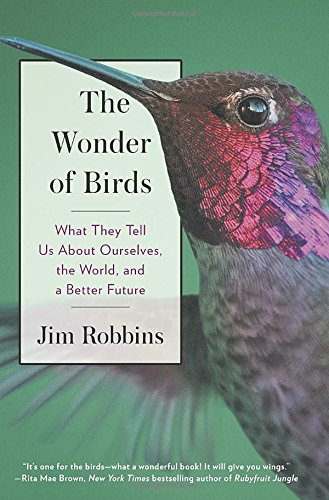The Wonder of Birds, by Jim Robbins
~ Anne Kilgannon
How do I choose a book to review here for Black Hills members? I am mindful that birds should be somehow at the center of my reading; that even if the book is about some larger exploration about climate, or environment, or conservation, at heart I’m thinking about how climate change will impact the birds I live near, or how we can save this habitat or special place, or how this visionary person has shown us the way to see nature more clearly, to live in such a way that birds can be our guide, our inspiration. Being intrigued by birds, caring for birds, really noticing birds and allowing birds to awaken wonder is a path for more conscious living and larger living. And, it turns out, many writers follow that path, some stumbling but searching, some with sublimity, many with stories and information that are revelations. The book I just finished reading—finished with regret—is such a book.
My notes from reading Jim Robbins’ The Wonder of Birds would fill an entire curriculum of study about human relationships with birds. Robbins references so many different ways of examining how birds reveal the workings of the world and tell us where we humans might fit—if we only would remember we are part of nature—and how we might create what he calls “a better future” for ourselves. From reminding us that birds see with an extra dimension to other beyond-human capabilities, Robbins weaves together a kaleidoscope of ways to be inspired by the marvels that are birds. Each chapter shifts and tilts the light this and that direction, demonstrating some surprising ways birds can add depth and breadth to how we perceive life.
Take starlings—getting past your immediate negative reaction, perhaps—and think about their flocking behavior. We call it murmuration: how they rise up as one and sweep across the sky without crashing into each other while executing split-second twists and turns. How do they do that? How are they communicating in what seem to be leaderless swarms? Are they flying as individuals or as some kind of meta-cognition apparition? What can we learn about perception from this incredible demonstration? And what might happen if habitat destruction or some other calamity should befall the population and their numbers shrink below some critical number of starlings? Would they lose that ability, that defining starling-nature? Is that what happened to passenger pigeons? And jumping into new territory, what happens to human cultures when languages are lost or stories that had bound together so many but are now lost?
That discussion was but one chapter. Now think about eagles and hawks; what can we learn about their sublimely fierce natures that might heal the psychic shocks experienced by the violent and broken lives of inner city youth?
Then: canaries have long been employed as sentinels of safety in deep mines tunneling into the earth. Other birds, if we pay attention, can alert us to other dangers. Black-backed woodpeckers act as harbingers of forest health after a fire. Look for them. Watch crows and ravens and other corvids to know what’s really going on nearby. Listen to chickadees for more news of the bird world. Contemplate the complicated family life of African bee-eaters to learn more about the sociological possibilities of group life. Ask yourself if chickens deserve better than the miserable lives we have reduced them to, from noble forest birds to near-machines.
Examine the architecture of a feather and imagine the possibilities of flight. How do bar-headed geese survive their migration over the oxygen-starved Himalayan mountains skyway? Or other birds migrate from pole to pole without getting lost or stopping to refuel? How do penguins manage their deep-sea dives in near freezing-water conditions? These stories of extreme adaptations stretch the limits of the possible. What can we learn about the edges of life from the exploits of “ordinary” birds? And so much more.
Robbins takes us on an extraordinary journey, offering us one bird story after another, urging us to rethink what we had maybe taken for granted, about birds, about nature in general and about ourselves. I came away with new lists to study, books and articles to read and TED talks to explore. That’s my measure of a great book: one full of amazing finds that then generate hunger for more, a smorgasbord of discoveries that raise more questions and point in new directions, and which set out further signposts to look here… and here… and here. There is so much to learn!








